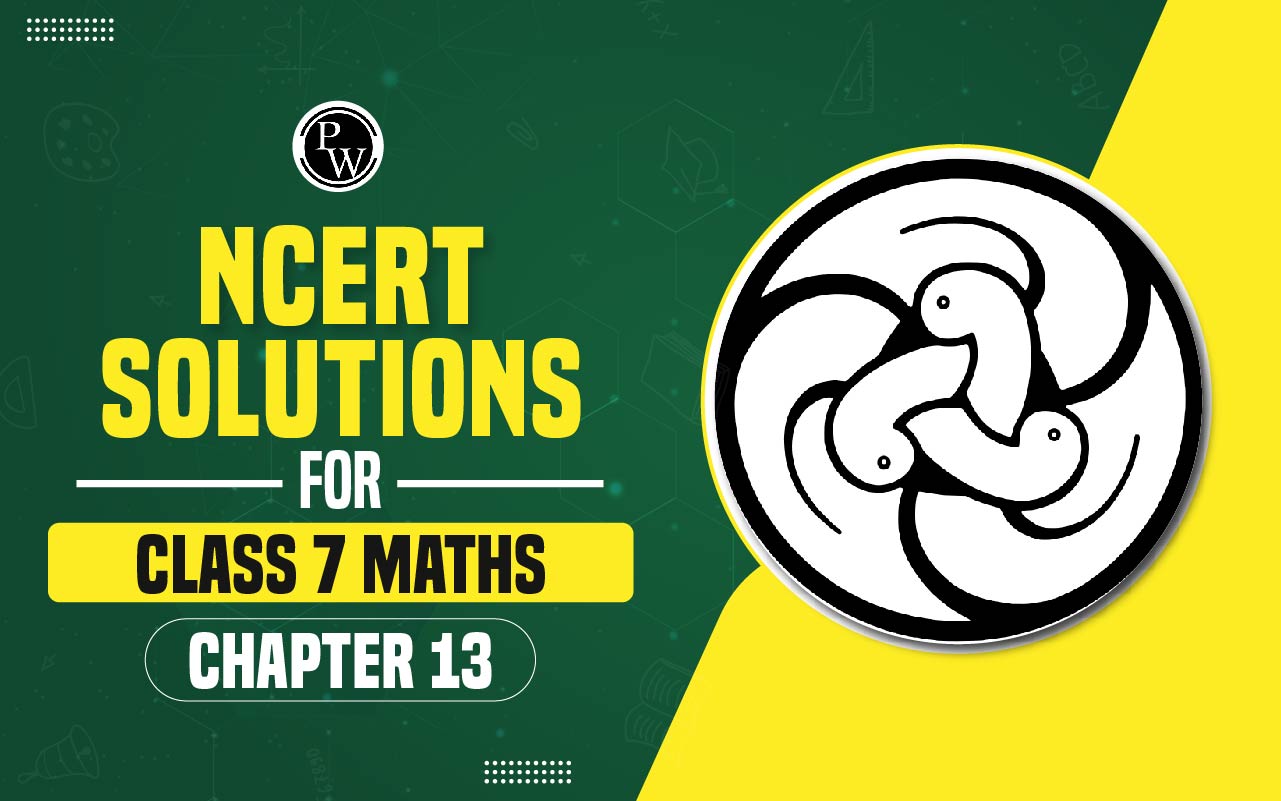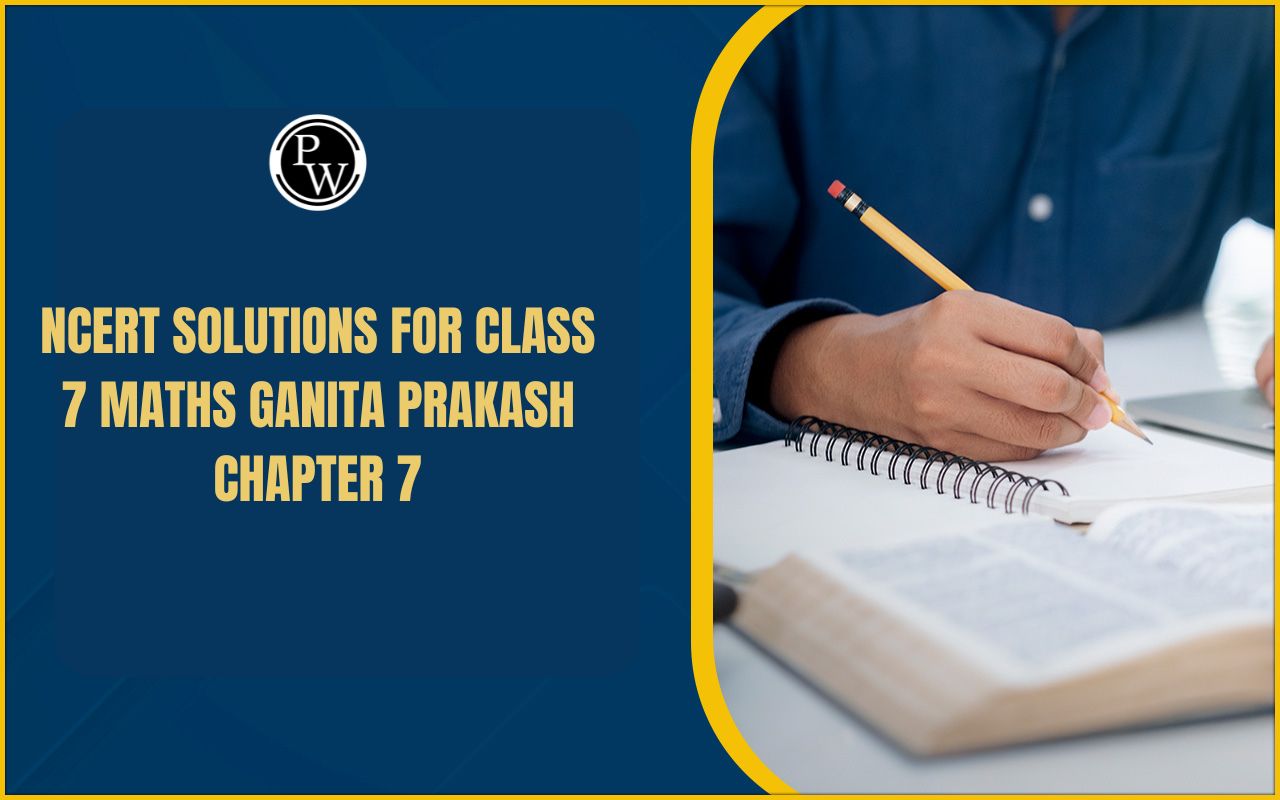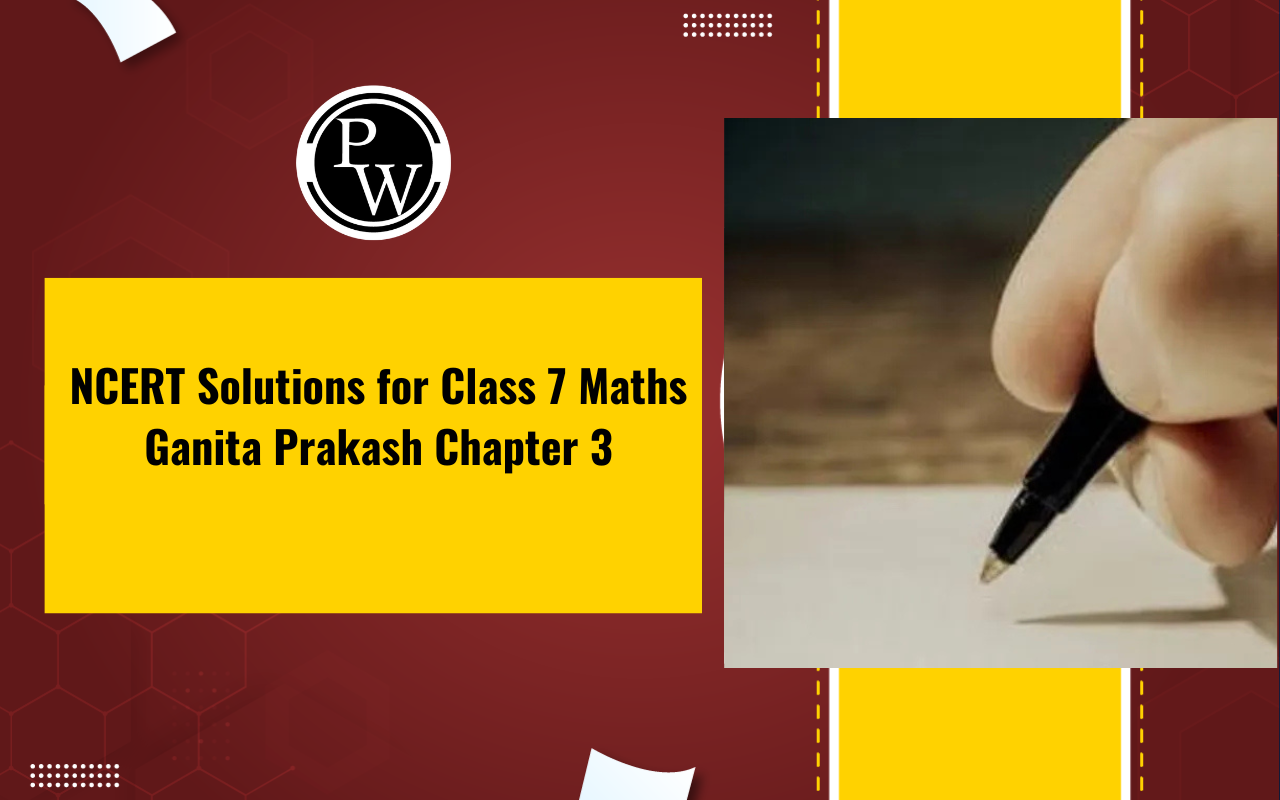

NCERT Solutions for Class 7 Maths Chapter 13
NCERT Solutions for Class 7 Maths Chapter 13: NCERT Solutions for Class 7 Maths Chapter 13 provide detailed explanations and answers to the exercises in the chapter on Exponents and Powers. With these solutions students can strengthen their understanding of the concepts and improve their problem-solving skills. Practicing with NCERT Solutions for Chapter 13 will help students prepare thoroughly for exams and build a strong foundation in mathematics.
CBSE Class 10 Science Sample Paper 2023-24
NCERT Solutions for Class 7 Maths Chapter 13 PDF
Below is the PDF link for NCERT Solutions for Class 7 Maths Chapter 13. This PDF provides detailed solutions to the exercises and problems presented in the chapter. By using this resource students can enhance their understanding of Exponents and Powers and practice solving various types of questions. Utilizing the PDF will aid students in strengthening their mathematical skills and preparing effectively for examinations.NCERT Solutions for Class 7 Maths Chapter 13 PDF
NCERT Solutions for Class 7 Maths Chapter 13 Exponents and Powers
Exercise 13.1 Page: 252
1. Find the value of:
(i) 2 6
Solution:-
The above value can be written as, = 2 × 2 × 2 × 2 × 2 × 2 = 64(ii) 9 3
Solution:-
The above value can be written as, = 9 × 9 × 9 = 729(iii) 11 2
Solution:-
The above value can be written as, = 11 × 11 = 121(iv) 5 4
Solution:-
The above value can be written as, = 5 × 5 × 5 × 5 = 6252. Express the following in exponential form:
(i) 6 × 6 × 6 × 6
Solution:-
The given question can be expressed in the exponential form as 6 4 .(ii) t × t
Solution:-
The given question can be expressed in the exponential form as t 2 .(iii) b × b × b × b
Solution:-
The given question can be expressed in the exponential form as b 4 .(iv) 5 × 5× 7 × 7 × 7
Solution:-
The given question can be expressed in the exponential form as 5 2 × 7 3 .(v) 2 × 2 × a × a
Solution:-
The given question can be expressed in the exponential form as 2 2 × a 2 .(vi) a × a × a × c × c × c × c × d
Solution:-
The given question can be expressed in the exponential form as a 3 × c 4 × d.3. Express each of the following numbers using the exponential notation:
(i) 512
Solution:-
The factors of 512 = 2 × 2 × 2 × 2 × 2 × 2 × 2 × 2 × 2 So it can be expressed in the exponential form as 2 9 .(ii) 343
Solution:-
The factors of 343 = 7 × 7 × 7 So it can be expressed in the exponential form as 7 3 .(iii) 729
Solution:-
The factors of 729 = 3 × 3 × 3 × 3 × 3 × 3 So it can be expressed in the exponential form as 3 6 .(iv) 3125
Solution:-
The factors of 3125 = 5 × 5 × 5 × 5 × 5 So it can be expressed in the exponential form as 5 5 .4. Identify the greater number, wherever possible, in each of the following.
(i) 4 3 or 3 4
Solution:-
The expansion of 4 3 = 4 × 4 × 4 = 64 The expansion of 3 4 = 3 × 3 × 3 × 3 = 81 Clearly, 64 < 81 So, 4 3 < 3 4 Hence, 3 4 is the greater number.(ii) 5 3 or 3 5
Solution:-
The expansion of 5 3 = 5 × 5 × 5 = 125 The expansion of 3 5 = 3 × 3 × 3 × 3 × 3= 243 Clearly, 125 < 243 So, 5 3 < 3 5 Hence, 3 5 is the greater number.(iii) 2 8 or 8 2
Solution:-
The expansion of 2 8 = 2 × 2 × 2 × 2 × 2 × 2 × 2 × 2 = 256 The expansion of 8 2 = 8 × 8= 64 Clearly, 256 > 64 So, 2 8 > 8 2 Hence, 2 8 is the greater number.(iv) 100 2 or 2 100
Solution:-
The expansion of 100 2 = 100 × 100 = 10000 The expansion of 2 100 2 10 = 2 × 2 × 2 × 2 × 2 × 2 × 2 × 2 × 2 × 2 = 1024 Then, 2 100 = 1024 × 1024 ×1024 × 1024 ×1024 × 1024 × 1024 × 1024 × 1024 × 1024 = (1024) 10 Clearly, 100 2 < 2 100 Hence, 2 100 is the greater number.(v) 2 10 or 10 2
Solution:-
The expansion of 2 10 = 2 × 2 × 2 × 2 × 2 × 2 × 2 × 2 × 2 × 2 = 1024 The expansion of 10 2 = 10 × 10= 100 Clearly, 1024 > 100 So, 2 10 > 10 2 Hence, 2 10 is the greater number.5. Express each of the following as a product of powers of their prime factors:
(i) 648
Solution:-
Factors of 648 = 2 × 2 × 2 × 3 × 3 × 3 × 3 = 2 3 × 3 4(ii) 405
Solution:-
Factors of 405 = 3 × 3 × 3 × 3 × 5 = 3 4 × 5(iii) 540
Solution:-
Factors of 540 = 2 × 2 × 3 × 3 × 3 × 5 = 2 2 × 3 3 × 5(iv) 3,600
Solution:-
Factors of 3600 = 2 × 2 × 2 × 2 × 3 × 3 × 5 × 5 = 2 4 × 3 2 × 5 26. Simplify:
(i) 2 × 10 3
Solution:-
The above question can be written as, = 2 × 10 × 10 × 10 = 2 × 1000 = 2000(ii) 7 2 × 2 2
Solution:-
The above question can be written as, = 7 × 7 × 2 × 2 = 49 × 4 = 196| CBSE Syllabus Class 7 | |
| CBSE Class 7 English Syllabus | CBSE Class 7 Math Syllabus |
| CBSE Class 7 Social Science Syllabus | CBSE Class 7 Science Syllabus |
(iii) 2 3 × 5
Solution:-
The above question can be written as, = 2 × 2 × 2 × 5 = 8 × 5 = 40(iv) 3 × 4 4
Solution:-
The above question can be written as, = 3 × 4 × 4 × 4 × 4 = 3 × 256 = 768(v) 0 × 10 2
Solution:-
The above question can be written as, = 0 × 10 × 10 = 0 × 100 = 0(vi) 5 2 × 3 3
Solution:-
The above question can be written as, = 5 × 5 × 3 × 3 × 3 = 25 × 27 = 675(vii) 2 4 × 3 2
Solution:-
The above question can be written as, = 2 × 2 × 2 × 2 × 3 × 3 = 16 × 9 = 144(viii) 3 2 × 10 4
Solution:-
The above question can be written as, = 3 × 3 × 10 × 10 × 10 × 10 = 9 × 10000 = 90000CBSE Board Exam Centre List 2024
7. Simplify:
(i) (– 4) 3
Solution:-
The expansion of -4 3 = – 4 × – 4 × – 4 = – 64(ii) (–3) × (–2) 3
Solution:-
The expansion of (-3) × (-2) 3 = – 3 × – 2 × – 2 × – 2 = – 3 × – 8 = 24(iii) (–3) 2 × (–5) 2
Solution:-
The expansion of (-3) 2 × (-5) 2 = – 3 × – 3 × – 5 × – 5 = 9 × 25 = 225(iv) (–2) 3 × (–10) 3
Solution:-
The expansion of (-2) 3 × (-10) 3 = – 2 × – 2 × – 2 × – 10 × – 10 × – 10 = – 8 × – 1000 = 80008. Compare the following numbers:
(i) 2.7 × 10 12 ; 1.5 × 10 8
Solution:-
By observing the question Comparing the exponents of base 10, Clearly, 2.7 × 10 12 > 1.5 × 10 8(ii) 4 × 10 14 ; 3 × 10 17
Solution:-
By observing the question Comparing the exponents of base 10, Clearly, 4 × 10 14 < 3 × 10 17Exercise 13.2 Page: 260
1. Using laws of exponents, simplify and write the answer in exponential form:
(i) 3 2 × 3 4 × 3 8
Solution:-
By the rule of multiplying the powers with the same base = a m × a n = a m + n Then, = (3) 2 + 4 + 8 = 3 14(ii) 6 15 ÷ 6 10
Solution:-
By the rule of dividing the powers with the same base = a m ÷ a n = a m – n Then, = (6) 15 – 10 = 6 5(iii) a 3 × a 2
Solution:-
By the rule of multiplying the powers with the same base = a m × a n = a m + n Then, = (a) 3 + 2 = a 5(iv) 7 x × 7 2
Solution:-
By the rule of multiplying the powers with the same base = a m × a n = a m + n Then, = (7) x + 2(v) (5 2 ) 3 ÷ 5 3
Solution:-
By the rule of taking the power of as power = (a m ) n = a mn (5 2 ) 3 can be written as = (5) 2 × 3 = 5 6 Now, 5 6 ÷ 5 3 By the rule of dividing the powers with the same base = a m ÷ a n = a m – n Then, = (5) 6 – 3 = 5 3(vi) 2 5 × 5 5
Solution:-
By the rule of multiplying the powers with the same exponents = a m × b m = ab m Then, = (2 × 5) 5 = 10 5(vii) a 4 × b 4
Solution:-
By the rule of multiplying the powers with the same exponents = a m × b m = ab m Then, = (a × b) 4 = ab 4(viii) (3 4 ) 3
Solution:-
By the rule of taking the power of as power = (a m ) n = a mn (3 4 ) 3 can be written as = (3) 4 × 3 = 3 12(ix) (2 20 ÷ 2 15 ) × 2 3
Solution:-
By the rule of dividing the powers with the same base = a m ÷ a n = a m – n (2 20 ÷ 2 15 ) can be simplified as, = (2) 20 – 15 = 2 5 Then, By the rule of multiplying the powers with the same base = a m × a n = a m + n 2 5 × 2 3 can be simplified as, = (2) 5 + 3 = 2 8(x) 8 t ÷ 8 2
Solution:-
By the rule of dividing the powers with the same base = a m ÷ a n = a m – n Then, = (8) t – 22. Simplify and express each of the following in exponential form:
(i) (2 3 × 3 4 × 4)/ (3 × 32)
Solution:-
Factors of 32 = 2 × 2 × 2 × 2 × 2 = 2 5 Factors of 4 = 2 × 2 = 2 2 Then, = (2 3 × 3 4 × 2 2 )/ (3 × 2 5 ) = (2 3 + 2 × 3 4 ) / (3 × 2 5 ) … [∵a m × a n = a m + n ] = (2 5 × 3 4 ) / (3 × 2 5 ) = 2 5 – 5 × 3 4 – 1 … [∵a m ÷ a n = a m – n ] = 2 0 × 3 3 = 1 × 3 3 = 3 3(ii) ((5 2 ) 3 × 5 4 ) ÷ 5 7
Solution:-
(5 2 ) 3 can be written as = (5) 2 × 3 … [∵(a m ) n = a mn ] = 5 6 Then, = (5 6 × 5 4 ) ÷ 5 7 = (5 6 + 4 ) ÷ 5 7 … [∵a m × a n = a m + n ] = 5 10 ÷ 5 7 = 5 10 – 7 … [∵a m ÷ a n = a m – n ] = 5 3Related Links -
(iii) 25 4 ÷ 5 3
Solution:-
(25) 4 can be written as = (5 × 5) 4 = (5 2 ) 4 (5 2 ) 4 can be written as = (5) 2 × 4 … [∵(a m ) n = a mn ] = 5 8 Then, = 5 8 ÷ 5 3 = 5 8 – 3 … [∵a m ÷ a n = a m – n ] = 5 5(iv) (3 × 7 2 × 11 8 )/ (21 × 11 3 )
Solution:-
Factors of 21 = 7 × 3 Then, = (3 × 7 2 × 11 8 )/ (7 × 3 × 11 3 ) = 3 1-1 × 7 2-1 × 11 8 – 3 = 3 0 × 7 × 11 5 = 1 × 7 × 11 5 = 7 × 11 5(v) 3 7 / (3 4 × 3 3 )
Solution:-
= 3 7 / (3 4+3 ) … [∵a m × a n = a m + n ] = 3 7 / 3 7 = 3 7 – 7 … [∵a m ÷ a n = a m – n ] = 3 0 = 1(vi) 2 0 + 3 0 + 4 0
Solution:-
= 1 + 1 + 1 = 3(vii) 2 0 × 3 0 × 4 0
Solution:-
= 1 × 1 × 1 = 1(viii) (3 0 + 2 0 ) × 5 0
Solution:-
= (1 + 1) × 1 = (2) × 1 = 2(ix) (2 8 × a 5 )/ (4 3 × a 3 )
Solution:-
(4) 3 can be written as = (2 × 2) 3 = (2 2 ) 3 (2 2 ) 3 can be written as = (2) 2 × 3 … [∵(a m ) n = a mn ] = 2 6 Then, = (2 8 × a 5 )/ (2 6 × a 3 ) = 2 8 – 6 × a 5 – 3 … [∵a m ÷ a n = a m – n ] = 2 2 × a 2 … [∵(a m ) n = a mn ] = 2a 2(x) (a 5 /a 3 ) × a 8
Solution:-
= (a 5 -3 ) × a 8 … [∵a m ÷ a n = a m – n ] = a 2 × a 8 = a 2 + 8 … [∵a m × a n = a m + n ] = a 10(xi) (4 5 × a 8 b 3 )/ (4 5 × a 5 b 2 )
Solution:-
= 4 5 – 5 × (a 8 – 5 × b 3 – 2 ) … [∵a m ÷ a n = a m – n ] = 4 0 × (a 3 b) = 1 × a 3 b = a 3 b(xii) (2 3 × 2) 2
Solution:-
= (2 3 + 1 ) 2 … [∵a m × a n = a m + n ] = (2 4 ) 2 (2 4 ) 2 can be written as = (2) 4 × 2 … [∵(a m ) n = a mn ] = 2 83. Say true or false and justify your answer:
(i) 10 × 10 11 = 100 11
Solution:-
Let us consider Left Hand Side (LHS) = 10 × 10 11 = 10 1 + 11 … [∵a m × a n = a m + n ] = 10 12 Now, consider Right Hand Side (RHS) = 100 11 = (10 × 10) 11 = (10 1 + 1 ) 11 = (10 2 ) 11 = (10) 2 × 11 … [∵(a m ) n = a mn ] = 10 22 By comparing LHS and RHS, LHS ≠ RHS Hence, the given statement is false.(ii) 2 3 > 5 2
Solution:-
Let us consider LHS = 2 3 Expansion of 2 3 = 2 × 2 × 2 = 8 Now, consider RHS = 5 2 Expansion of 5 2 = 5 × 5 = 25 By comparing LHS and RHS, LHS < RHS 2 3 < 5 2 Hence, the given statement is false.(iii) 2 3 × 3 2 = 6 5
Solution:-
Let us consider LHS = 2 3 × 3 2 Expansion of 2 3 × 3 2 = 2 × 2 × 2 × 3 × 3 = 72 Now, consider RHS = 6 5 Expansion of 6 5 = 6 × 6 × 6 × 6 × 6 = 7776 By comparing LHS and RHS, 72 ≠ 7776 LHS ≠ RHS Hence, the given statement is false.(iv) 3 0 = (1000) 0
Solution:-
Let us consider LHS = 3 0 = 1 Now, consider RHS = 1000 0 = 1 By comparing LHS and RHS, LHS = RHS 3 0 = 1000 0 Hence, the given statement is true.4. Express each of the following as a product of prime factors only in exponential form:
(i) 108 × 192
Solution:-
The factors of 108 = 2 × 2 × 3 × 3 × 3 = 2 2 × 3 3 The factors of 192 = 2 × 2 × 2 × 2 × 2 × 2 × 3 = 2 6 × 3 Then, = (2 2 × 3 3 ) × (2 6 × 3) = 2 2 + 6 × 3 3 + 1 … [∵a m × a n = a m + n ] = 2 8 × 3 4(ii) 270
Solution:-
The factors of 270 = 2 × 3 × 3 × 3 × 5 = 2 × 3 3 × 5(iii) 729 × 64
The factors of 729 = 3 × 3 × 3 × 3 × 3 × 3 = 3 6 The factors of 64 = 2 × 2 × 2 × 2 × 2 × 2 = 2 6 Then, = (3 6 × 2 6 ) = 3 6 × 2 6(iv) 768
Solution:-
The factors of 768 = 2 × 2 × 2 × 2 × 2 × 2 × 2 × 2 × 3 = 2 8 × 35. Simplify:
(i) ((2 5 ) 2 × 7 3 )/ (8 3 × 7)
Solution:-
8 3 can be written as = (2 × 2 × 2) 3 = (2 3 ) 3 We have, = ((2 5 ) 2 × 7 3 )/ ((2 3 ) 3 × 7) = (2 5 × 2 × 7 3 )/ ((2 3 × 3 × 7) … [∵(a m ) n = a mn ] = (2 10 × 7 3 )/ (2 9 × 7) = (2 10 – 9 × 7 3 – 1 ) … [∵a m ÷ a n = a m – n ] = 2 × 7 2 = 2 × 7 × 7 = 98(ii) (25 × 5 2 × t 8 )/ (10 3 × t 4 )
Solution:-
25 can be written as = 5 × 5 = 5 2 10 3 can be written as = 10 3 = (5 × 2) 3 = 5 3 × 2 3 We have, = (5 2 × 5 2 × t 8 )/ (5 3 × 2 3 × t 4 ) = (5 2 + 2 × t 8 )/ (5 3 × 2 3 × t 4 ) … [∵a m × a n = a m + n ] = (5 4 × t 8 )/ (5 3 × 2 3 × t 4 ) = (5 4 – 3 × t 8 – 4 )/ 2 3 … [∵a m ÷ a n = a m – n ] = (5 × t 4 )/ (2 × 2 × 2) = (5t 4 )/ 8(iii) (3 5 × 10 5 × 25)/ (5 7 × 6 5 )
Solution:-
10 5 can be written as = (5 × 2) 5 = 5 5 × 2 5 25 can be written as = 5 × 5 = 5 2 6 5 can be written as = (2 × 3) 5 = 2 5 × 3 5 Then we have, = (3 5 × 5 5 × 2 5 × 5 2 )/ (5 7 × 2 5 × 3 5 ) = (3 5 × 5 5 + 2 × 2 5 )/ (5 7 × 2 5 × 3 5 ) … [∵a m × a n = a m + n ] = (3 5 × 5 7 × 2 5 )/ (5 7 × 2 5 × 3 5 ) = (3 5 – 5 × 5 7 – 7 × 2 5 – 5 ) = (3 0 × 5 0 × 2 0 ) … [∵a m ÷ a n = a m – n ] = 1 × 1 × 1 = 1 Exercise 13.3 Page: 2631. Write the following numbers in the expanded forms:
(a) 279404
Solution:-
The expanded form of the number 279404 is, = (2 × 100000) + (7 × 10000) + (9 × 1000) + (4 × 100) + (0 × 10) + (4 × 1) Now we can express it using powers of 10 in the exponent form, = (2 × 10 5 ) + (7 × 10 4 ) + (9 × 10 3 ) + (4 × 10 2 ) + (0 × 10 1 ) + (4 × 10 0 )(b) 3006194
Solution:-
The expanded form of the number 3006194 is, = (3 × 1000000) + (0 × 100000) + (0 × 10000) + (6 × 1000) + (1 × 100) + (9 × 10) + (4 × 1) Now we can express it using powers of 10 in the exponent form, = (3 × 10 6 ) + (0 × 10 5 ) + (0 × 10 4 ) + (6 × 10 3 ) + (1 × 10 2 ) + (9 × 10 1 ) + (4 × 10 0 )(c) 2806196
Solution:-
The expanded form of the number 2806196 is, = (2 × 1000000) + (8 × 100000) + (0 × 10000) + (6 × 1000) + (1 × 100) + (9 × 10) + (6 × 1) Now we can express it using powers of 10 in the exponent form, = (2 × 10 6 ) + (8 × 10 5 ) + (0 × 10 4 ) + (6 × 10 3 ) + (1 × 10 2 ) + (9 × 10 1 ) + (6 × 10 0 )(d) 120719
Solution:-
The expanded form of the number 120719 is, = (1 × 100000) + (2 × 10000) + (0 × 1000) + (7 × 100) + (1 × 10) + (9 × 1) Now we can express it using powers of 10 in the exponent form, = (1 × 10 5 ) + (2 × 10 4 ) + (0 × 10 3 ) + (7 × 10 2 ) + (1 × 10 1 ) + (9 × 10 0 )(e) 20068
Solution:-
The expanded form of the number 20068 is, = (2 × 10000) + (0 × 1000) + (0 × 100) + (6 × 10) + (8 × 1) Now we can express it using powers of 10 in the exponent form, = (2 × 10 4 ) + (0 × 10 3 ) + (0 × 10 2 ) + (6 × 10 1 ) + (8 × 10 0 )2. Find the number from each of the following expanded forms:
(a) (8 × 10) 4 + (6 × 10) 3 + (0 × 10) 2 + (4 × 10) 1 + (5 × 10) 0
Solution:-
The expanded form is, = (8 × 10000) + (6 × 1000) + (0 × 100) + (4 × 10) + (5 × 1) = 80000 + 6000 + 0 + 40 + 5 = 86045(b) (4 × 10) 5 + (5 × 10) 3 + (3 × 10) 2 + (2 × 10) 0
Solution:-
The expanded form is, = (4 × 100000) + (0 × 10000) + (5 × 1000) + (3 × 100) + (0 × 10) + (2 × 1) = 400000 + 0 + 5000 + 300 + 0 + 2 = 405302(c) (3 × 10) 4 + (7 × 10) 2 + (5 × 10) 0
Solution:-
The expanded form is, = (3 × 10000) + (0 × 1000) + (7 × 100) + (0 × 10) + (5 × 1) = 30000 + 0 + 700 + 0 + 5 = 30705(d) (9 × 10) 5 + (2 × 10) 2 + (3 × 10) 1
Solution:-
The expanded form is, = (9 × 100000) + (0 × 10000) + (0 × 1000) + (2 × 100) + (3 × 10) + (0 × 1) = 900000 + 0 + 0 + 200 + 30 + 0 = 9002303. Express the following numbers in standard form:
(i) 5,00,00,000
Solution:-
The standard form of the given number is 5 × 10 7(ii) 70,00,000
Solution:-
The standard form of the given number is 7 × 10 6(iii) 3,18,65,00,000
Solution:-
The standard form of the given number is 3.1865 × 10 9(iv) 3,90,878
Solution:-
The standard form of the given number is 3.90878 × 10 5(v) 39087.8
Solution:-
The standard form of the given number is 3.90878 × 10 4(vi) 3908.78
Solution:-
The standard form of the given number is 3.90878 × 10 34. Express the number appearing in the following statements in standard form.
(a) The distance between Earth and Moon is 384,000,000 m.
Solution:-
The standard form of the number appearing in the given statement is 3.84 × 10 8 m.(b) Speed of light in a vacuum is 300,000,000 m/s.
Solution:-
The standard form of the number appearing in the given statement is 3 × 10 8 m/s.(c) Diameter of the Earth is 1,27,56,000 m.
Solution:-
The standard form of the number appearing in the given statement is 1.2756 × 10 7 m.(d) Diameter of the Sun is 1,400,000,000 m.
Solution:-
The standard form of the number appearing in the given statement is 1.4 × 10 9 m.(e) In a galaxy, there are, on average, 100,000,000,000 stars.
Solution:-
The standard form of the number appearing in the given statement is 1 × 10 11 stars.(f) The universe is estimated to be about 12,000,000,000 years old.
Solution:-
The standard form of the number appearing in the given statement is 1.2 × 10 10 years old.(g) The distance of the Sun from the centre of the Milky Way Galaxy is estimated to be 300,000,000,000,000,000,000 m.
Solution:-
The standard form of the number appearing in the given statement is 3 × 10 20 m.(h) 60,230,000,000,000,000,000,000 molecules are contained in a drop of water weighing 1.8 gm.
Solution:-
The standard form of the number appearing in the given statement is 6.023 × 10 22 molecules.(i) The Earth has 1,353,000,000 cubic km of seawater.
Solution:-
The standard form of the number appearing in the given statement is 1.353 × 10 9 cubic km.(j) The population of India was about 1,027,000,000 in March 2001.
Solution:-
The standard form of the number appearing in the given statement is 1.027 × 10 9 .NCERT Solutions for Class 7 Maths Chapter 13 FAQs
What are exponents?
What is the difference between exponent and power?
How do you read expressions with exponents?
What are some properties of exponents?











